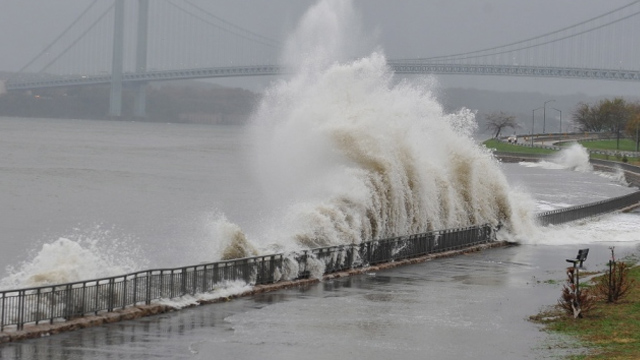In the wake of Superstorm Sandy, which left a devastating trail of destruction, power failures and flooding in its wake, people all over are wondering whether the “Frankenstorm” is related in any way to climate change. Has global warming helped create the conditions that make freak storms like Sandy happen? Writing for Climate Desk, Chris Mooney asked a handful of climate scientists this question, and here is a quick breakdown of what he found:
1. Precipitation: “I have no equivocation in saying that all heavy rainfall events, including this one, have an element of climate change in them, and the level of that contribution will increase in the future,” explains meteorologist Greg Holland of the National Center for Atmospheric Research.
2. Storm surge: There’s no doubt that global warming has raised the sea level, meaning that every hurricane—including Sandy—surfs atop a higher ocean and can penetrate further inland.
3. Ocean temperatures: Warm oceans are jet fuel for hurricanes, so it’s fair to say that these warmer temperatures are revving Sandy’s engine.
4. Massive size: The most striking and destructive aspect of Sandy is its breadth—tropical-storm-force winds reached a radius of 520 miles at one point yesterday. So is global warming involved in making storms bigger, overall? According to MIT hurricane expert Kerry Emanuel, it might be—but probably only a little. “For ordinary hurricanes, we actually expect a little increase in the size, based upon recent work we’ve done,” Emanuel explains. “Not spectacular, but a little increase in size.”
5. Hybrid storms and climate change: Sandy, continues Emanuel, is a “hybrid storm.” Such hybrids do occur around the world with some regularity, but how is global warming changing them? That’s less clear, Emanuel remarks. Unlike for hurricanes, “nobody has bothered to compile a comprehensive climatology of hybrid storms,” he says. “So there’s nowhere to go to see the characteristics of these storms changing.”
There you have it. Read the article here.
(via Guardian, Climate Desk)
Photo: Waves slam the coast of Gravesend Bay hours before Sandy made landfall on Oct. 29, 2012. (Todd Maisel / New York Daily News)
